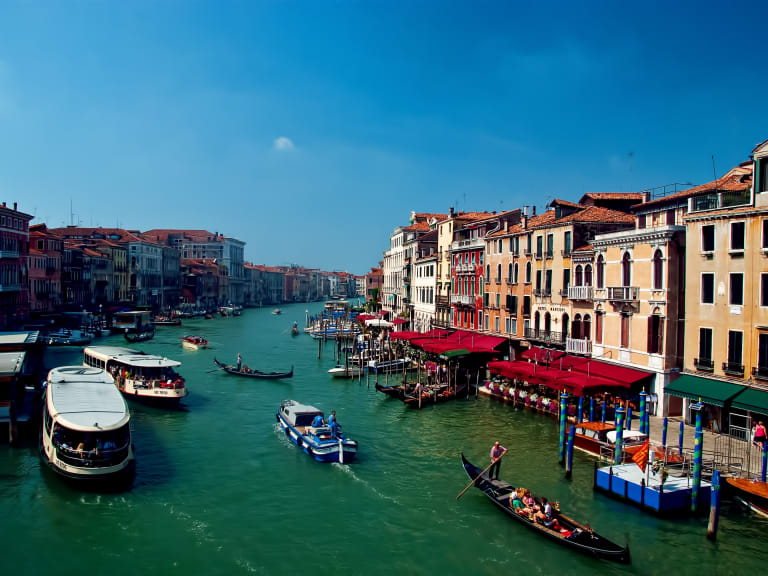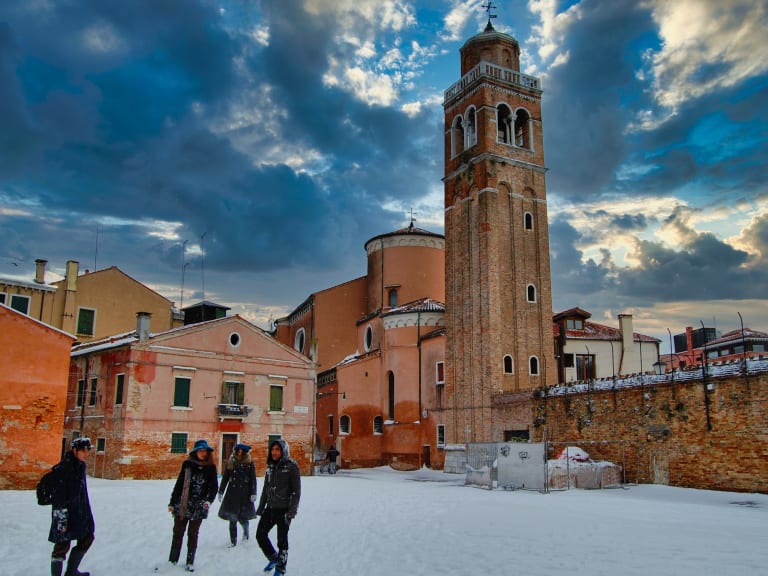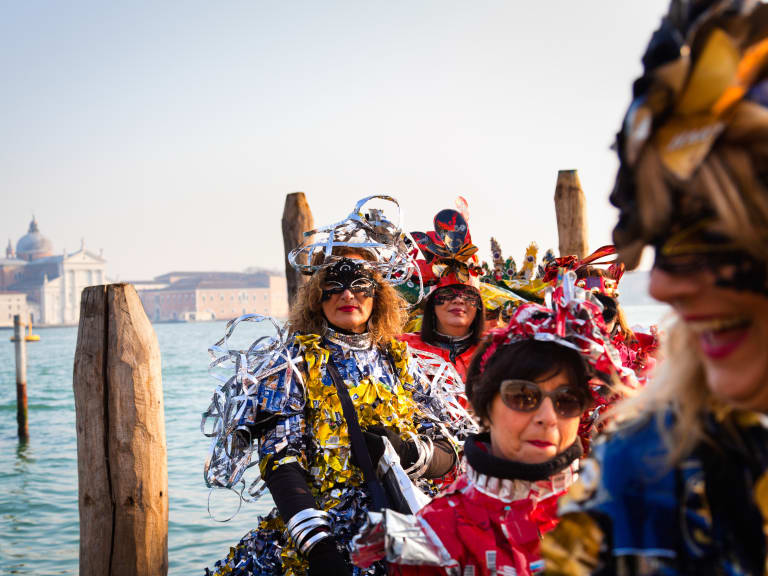Best Time of Year for Visiting Venice
Venice, known as the City of Canals or the Pearl of the Adriatic, is one of those cities that you have to visit at least once in a lifetime. However, there are always some better times than others to travel to it.

Venice, Italy | ©Stijn te Strake
No matter when you travel to the city, Venice' s attractions will always be waiting for you. From its palaces to the extraordinary St. Mark's Basilica, its entertaining markets, its beautiful bridges and, of course, its canals, this Italian city never disappoints anyone.
This does not mean that there are no more suitable times to travel than others. The weather, the influx of tourists, prices and other factors mean that some seasons may be better to enjoy your stay. In general, the spring and early autumn months are the most comfortable if all circumstances are analyzed. In any case, if you can only go in summer or winter I advise you not to hesitate.
When is the best time to travel to Venice?

The weather is one of the main factors that will mark the best time to travel to Venice. In this city, winters are usually quite cold, while the summer months are characterized by heat and humidity. In general, if you have a choice, the best times to visit are the late spring and early autumn months.
In both periods the weather gives a respite, with mild temperatures, although the possibility of rain is always present. However, compared to the summer, these are seasons with somewhat less tourist influx, which will allow you to stroll more quietly through streets and canals. The weather in these seasons, however, can be somewhat unpredictable, so always check the forecast before traveling.
As a brief summary of pros and cons, here is a note of each season:
- Spring (March-mid June): with the exception of Easter, prices are somewhat lower and you will see fewer tourists than in summer but increasing with the passing of the season.
- Summer (mid-June-late September): the city fills up with visitors and crowds are the norm. The weather is very hot and prices go up. The positive aspect is the possibility of enjoying more daylight hours and the Venetian night.
- Autumn: (end of September - mid-December): the large crowds begin to disappear little by little. The heat is descending, without the cold still appearing. However, there is more chance of rain and the phenomenon of acqua alta.
- Winter (late December-mid March): the coldest and darkest months of the year, so daylight hours are greatly reduced. Christmas and Carnival are two very busy times, especially the latter.
Traveling to Venice in spring: the best time to tour the city

The spring months are the perfect time to travel to Venice. Temperatures are milder and you will find fewer tourists on the streets or queuing to enter, for example, the Doge's Palace.
Within the season perhaps the month of May stands out. During this time you will be able to take advantage of the evenings, as the hours of daylight gradually increase. Temperatures, meanwhile, can reach around 20 degrees Celsius, although it is normal for them to be a few degrees lower.
In March and April, meanwhile, there may be some moments of cold, but less annoying than in the winter months. The only problem is that this is one of the rainiest periods in the city.
April and May are the best months for strolling along the city's streets and canals, as well as for excursions from Venice to nearby Burano, Murano and Torcello. The former, in particular, is at its best thanks to the effect of the spring light on its colorful houses.
However, spring also has its downside. From the end of April there is an increase in the prices of flights and accommodation. This makes it necessary to book earlier and even choose hotels in a nearby town, such as Mestre. Fortunately, there are enough transportation options to get around Venice to reach Venice in just 15 minutes.
Activities if you travel to Venice in spring
If you decide to or can travel to Venice in spring there are some activities you should not miss, in addition, of course, to the more usual visits:
- Su E Zo per i Ponti: it is a race open to everyone that runs from the Straw Bridge to St. Mark's Square. Along the way, bridges are crossed all over Venice.
- Festivity of St. Mark: on the day of the city's patron saint, April 25, there is an interesting gondola regatta, among other celebrations.
- La Sensa: this festival mixes its religious character with the celebration of Venice's relationship with the sea. It is one of the most beloved festivities by Venetians and is full of cultural and leisure activities.
Traveling to Venice in summer: heat, crowds and great atmosphere

Most visits to Venice occur during the summer, during the time when most people are able to take a vacation. The first consequence is that the city fills up with visitors from all over the world. Spaces such as St. Mark's Square become a bit uncomfortable, especially when cruise passengers disembark.
This overcrowding causes long lines to enter the most important monuments of Venice, so buying tickets in advance and with the option to avoid waiting is more essential than ever. As for gondola rides, during this season there is usually a lot of traffic on the Grand Canal and travel is slower and more complicated.
On the other hand, the weather in Venice at this time is quite hot. It is a humid heat and can be uncomfortable for some visitors unaccustomed to such temperatures. However, this also has its positive side: the almost total absence of rain and the many hours of daylight that allow the evenings to be very long.
Prices, obviously, tend to increase quite a lot and it is highly recommended to plan everything well in advance.
Activities if you travel to Venice in summer
Being high season, Venice offers its visitors a large number of events and festivals. Some of them are almost a must if you are in the city:
- La Festa del Redentore: this is the most important celebration of the summer. It takes place in the third week of July and, among other entertainment options, offers an extraordinary fireworks display.
- Venice International Film Festival: in the first week of September Venice hosts its famous film festival. You can go to the Lido island to see some international stars and, of course, attend the premieres.
- Go to the beach: Venice is surrounded by several islands with beaches considered among the best in Italy. If the heat gets too much (or if you go to Venice with children) you can always spend a few hours on the beaches of Lido or Jesolo.
Traveling to Venice in autumn: more tranquility and still pleasant weather

The first weeks of autumn, from the end of September in Venice to the last days of October in Venice, Venice offers great advantages to its visitors. For starters, daylight hours are still plentiful and temperatures are usually mild. However, be aware that the nights start to get colder, with lows that can drop to as low as 8º.
November in Venice and early December are colder months, although not cold enough to make the visit too uncomfortable.
On the other hand, one phenomenon that can make visitors uncomfortable is acqua alta, the phenomenon that causes many areas of Venice to flood for two or three hours. Normally, the water level does not rise too high and the city is used to living with it. Only if you are unlucky enough to experience a serious episode will you have to stop your tour until everything returns to normal.
With the passing of autumn, the presence of tourists also decreases considerably. This makes this season the best to stroll comfortably through the streets of the city and to visit attractions such as the Basilica of St. Mark without stress.
Activities if you travel to Venice in autumn
Although there are not as many as in summer, Venice also has some important festivals that are celebrated in autumn. In addition, the lesser influx of tourists makes them festivities in which Venetians acquire more prominence:
- Regata Storica of Venice: one of the great celebrations of Venice. Besides enjoying music, drinks and food, you will be able to watch several spectacular regattas and a parade in period costumes.
- Halloween in Venice: for some years now, Venetians have been celebrating Halloween in style. Its streets and squares are filled with costumes and, of course, Venetian masks.
- Madonna della Salute: on November 21, Venice celebrates the end of the great plague epidemic of the 17th century. Many Venetians cross the Rialto Bridge to go to the esplanade of the Basilica of Santa Maria della Salute. The celebration takes place at the Basilica of Santa Maria della Salute.
Travel to Venice in winter: cold, humidity and a special atmosphere

Winter in Venice is considered the worst time to visit Venice, although paradoxically it is when the city's quintessential event takes place: the carnival. There is no doubt that the cold and rain that characterize this season make many tourists avoid visiting, but traveling at this time also has its charm.
Thus, the city takes on a darker aspect and it is not uncommon to find fog among its canals. On the positive side, this gives it a different, almost ghostly atmosphere that many may like.
On the other hand, this is the time when you will be able to find better prices, with the exception of the aforementioned carnival and Christmas in Venice. Also, walking through the streets and canals is much more comfortable, as well as visiting the monuments.
Activities if you travel to Venice in winter
The cold of winter does not prevent the Venetians from celebrating two of their great festivals: Christmas and Carnival. During them, the tranquility of the city is broken at this time and finding a place in their hotels can be complicated:
- Carnival: for about 10 days in February in Venice, the city lives intensely its star party. Events, parties, dances and parades are continuous, but the crowds are enormous.
- Christmas: from about the second week of December in Venice, Venice decorates and illuminates its streets to celebrate Christmas. During these days you can go to the flea markets, skate on a large ice rink or celebrate the farewell of the year.
- Day of the witch Befana: the Befana is in charge of bringing gifts to Venetian children. On January 6, a regatta takes place in which all the crew members dress up as this character.
Comparison of the different seasons to visit Venice
So that you have the information clearer and at hand, here is a table with data on the different times of the year to visit Venice.
- Spring
- March-June
- Highest 21°C
- Lowest 12°C
- The best: the weather and less tourists than in summer
- The worst: the chances of rain
- Summer
- June-September
- Highest 28°C
- Lowest 18°C
- The best: more daylight hours and the atmosphere
- The worst: heat and crowds
- Autumn
- September-December
- Maximum 15º C
- Minimum 10º C
- Best: less crowds and more tranquility
- Worst: humidity and less daylight hours
- Winter
- December-March
- High 9º C
- Low 0º C
- Best: lack of tourists and the effect of winter light
- Worst: cold, humidity and high water
Is it worth traveling to Venice during Carnival?

The short answer is yes, but the long answer is much more nuanced. During its most important festival, all the streets and squares of Venice are filled with people in costumes and with the popular carnival masks. Also, many balls are organized, some exclusive and others that you can access as a visitor.
During the days of the festival, attendees will find a large number of events, although it is perhaps during the Venetian night when the celebration is best experienced.
However, this period is not the best if what you want is to make the classic visits to monuments and museums. The amount of tourists everywhere makes it not too comfortable to move around.
On the other hand, the hotels are full and it is very likely that you will have to look for one quite far from the city.
Best time to travel in Venice if you want to ride in a gondola

One of the experiences that almost all visitors have in mind when they travel to Venice is to take a gondola ride. These tours are available all year round, but there are some times of the year that are better than others.
The summer, for example, is weighed down by the number of visitors to the city. It is not uncommon for boat jams to form on the canals and the experience loses some of its charm.
The best times to hire a gondola are in early spring or autumn, when the canals become quite clear.
A very interesting but rather overlooked time for these rides is winter. The gondoliers usually lend a blanket for those interested to cover themselves on board and, in addition, the dim light increases the romanticism of the experience.
